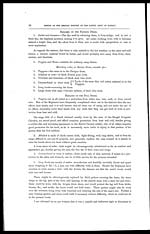Medicine - Institutions > Army health reports and medical documents > Sketch of the medical history of the native army of Bombay > Sketch of the medical history of the native army of Bombay, for the year 1870
(130) Page 57
Download files
Individual page:
Thumbnail gallery: Grid view | List view

57
NORTHERN AND MHOW DIVISIONS OF THE ARMY.
see the men of the 3rd Bombay Cavalry (who wear similar boots but not so long or heavy),
toiling up the steep mountain passes where they were forced to walk and lead their horses in
hand.
3. Trowsers and breeches.
6. Cloak.
These need no remark being, of good material and as well
fitting as circumstances and bad tailors will allow.
Gymnasium .—There is an English gymnasium in the Regiment, and certainly the few
that attend it regularly, testify to its use by their improved carriage and appearance, but as
attendance at the English talim is voluntary, the men prefer the bazaar or their own native
talim, and notwithstanding every effort being made to excite their ambition, there are only
very few who attend regularly, and these principally Maharattas; the other castes, high caste
men especially, seem to think that there is something derogatory to their dignity in gymnastic
feats.
There can be no doubt as to the beneficial results that would arise from a properly con-
ducted Regimental gymnasium, but until some assistance from Government is obtainable,
little can be done. At present the few European Officers of the Regiment subscribe monthly
to the gymnasium fund, from which instructors are paid and prizes occasionally given for
competition; the amount obtained in this manner is however very small and insufficient.
Water Supply .—In reporting upon the water-supply, it will be necessary to make great
allowances for the defects inseparable from the sandy formation of the soil of Deesa. The
general depth of wells in this cantonment is from 40 to 60 feet, the depth being greater as the
position of the well is altered with reference to the level of the Bunas river, the level of the
well water being solely affected by that of the river. The depth of the subsoil water is nowhere
less than 40 feet. As far as has yet been excavated, no other formation than sand has been.
found in the cantonment, although there is clay near the surface a little way out. Considering
the circumstances as regards the position of the wells in the Cavalry lines, it is strange that
there is not more contamination of the water by organic matter. For taking into consid-
eration that sand, through which alone (in Deesa) the surface water has to filter, is no
decomposer of organic matter; and taking the area around the wells upon which, in proportion,
more organic matter of sorts (especially horse manure and urine) is deposited than in any other
equal area in the station, it is easy to imagine how a large quantity of organized matter should
get into the water. And again, as the wells are open, and in the hot season the manure,
even what remains after burning, being thoroughly dry, is easily carried about by the wind,
a great deal of the dust arising from the lines is impregnated with organic matter, and a
certain proportion of both must necessarily be deposited in the wells during the three months
of the warm weather in which high winds prevail.
Squadron, strength 105, of the 1st Regiment A. L. C.
Rajcote.—Health good.
G. M.'s 2Oth Regiment A. I.
Deesa.—In Medical charge of Assistant Surgeon H. DETATHAM, Strength 630.
Europeans 6.
Natives 630.
Stations.
Deesa, from 1st January to 2nd November 1870.
On the march, 2nd November to 22nd November 1870.
Bhooj, 22nd November to 31st December 1870.
Detachment—none.
15 s
Set display mode to: Large image | Zoom image | Transcription
Images and transcriptions on this page, including medium image downloads, may be used under the Creative Commons Attribution 4.0 International Licence unless otherwise stated. ![]()
| Permanent URL | https://digital.nls.uk/75007140 |
|---|




